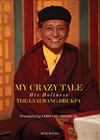 |
 |
 |
 |
Thubten Gyatso, the Thirteenth Dalai Lama, was born to a peasant family in 1876. He was discovered, brought to Lhasa and enthroned at the age of three. Educated as a monk, he took over full power when he was eighteen and ruled until his death thirty-seven years later. His rule would prove to be more strong, more radical and more complete than that of any Dalai Lama since the Great Fifth.
"His courage and energy were inexhaustible. He recoiled from nothing," writes Charles Bell, who as political officer in the Himalayas first met him in 1910. They developed a firm and affectionate friendship, politically and personally, that would last for twenty-five years.
"Portrait" is packed full of history, stories, facts and figures, anecdotes and conversation, and is compelling reading. Bell describes all aspects of Tibetan life, religion and politics- the very heart of which is the Dalai Lama. He paints a vivid and masterly picture of this powerful yet humble man of Tibet who struggled continually against both political and military onslaughts from China, fought vainly for support from the outside world, and who made radical changes at every level of life in his medieval nation, uniting and strengthening her as never before.
Portrait of a Dalai Lama, Sir Charles Bell, Wisdom Publications, 467 pages, $22.95
Sir Charles Bell was born in Calcutta in 1870 and educated in England at Winchester and Oxford. He joined the Indian Civil Service in 1891 and was transferred to Kalimpong, Sikkim, in 1901, where he began his lifelong relationship with Tibet. He twice acted as Political Officer for Sikkim, Bhutan, and Tibet and eventually held that post for ten years before retiring in 1919. He was recalled to duty, however, and in 1920 headed a successful diplomatic mission to Lhasa. He was created a K.C.I.E in 1922. In 1939 he moved to Canada. Portrait of a Dalai Lama was first published in 1946, a year after he died.
|
|
 |
 |
 |
 |

|



